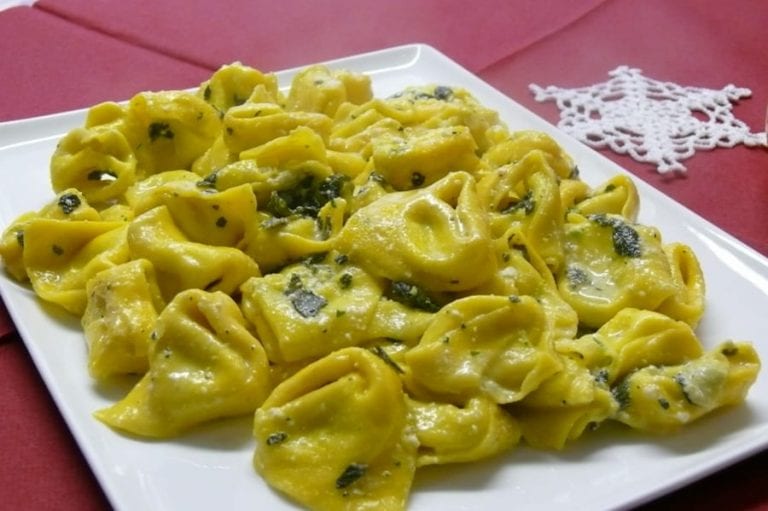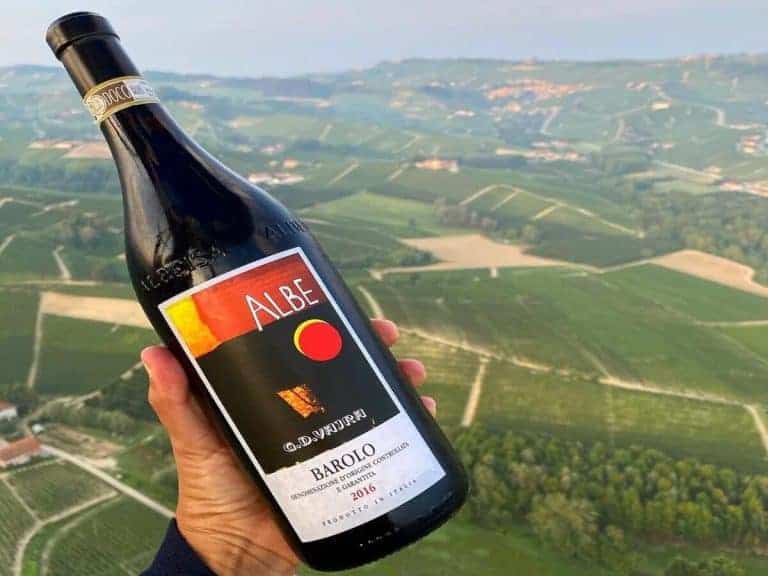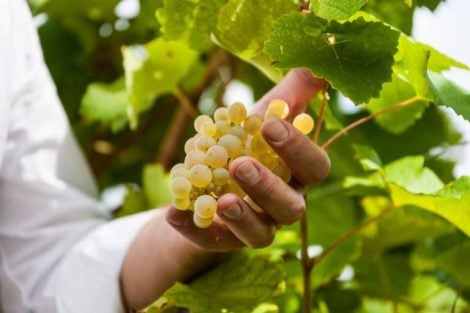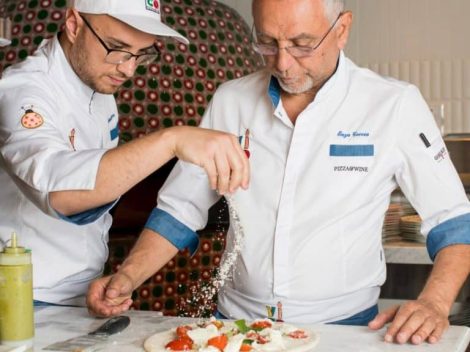How many pasta shapes exist in Italy? Many, as seen in our recent survey on the staggering variety of regional specialties. Stuffed pasta, simple water and flour, with egg yolks, stubby and noodle-like, ancient and modern, typical of specific villages and common to the whole territory: whatever their characteristic, pasta dishes remain the undisputed protagonists of Italian cuisine. And party meals are no exception: on Christmas, the regions of the peninsula unleash their cultural and gastronomic identity, bringing to the table the best local delicacies. Here are the best pasta shapes Italians prepare during the holidays.
Agnolotti del plin
Among the many variations of agnolotti pasta pockets, worthy of mention are the famous agnolotti del plin, pockets of egg-dough pasta filled with veal and pork, sometimes also available in the green version that includes spinach in the dough, characterised by the type of particular crimping, born in the Langhe but soon spread throughout the rest of the region. The "plin", in fact, is the pinch that performed to seal the square-shaped pocket. These are usually seasoned with brown butter, sage and parmigiano, or with pot roast sauce, parmigiano and truffle, or other white sauces which enhance the taste of the product.
Calzoncelli
Aka agnolotti baresi, calzoncieddi or cazune, these filled dumplings are famous especially in the sweet version, particularly common during the Christmas holidays, with a filling made with chestnuts, honey, orange peel and cacao. This is a type of ravioli that were initially conceived as a savoury specialty and then reinterpreted by the Apulian housewives in the sweet variant. The dough is made with semolina and water (sometimes with the addition of egg yolks) and is stuffed with a ricotta and egg mixture, or with minced meat.
Canederli
The famous dumplings of stale bread, flour, eggs, speck, parsley and parmigiano, also known by the German name knödele and present in almost all of northern Italy, from Trentino to Lombardy and the Veneto Alps, are a northern Italian staple during the holiday period. There are many variations, each with different ingredients and proportions, so much so that Felice Libera in his "The art of cooking: recipes of food and desserts, Trentino cookery and baking manuscript of the 18th century" lists more than fifteen.
Cappelletti
Present in Rome since the early 20th century, when women and children gathered on Christmas Eve to prepare lunch for December 25, cappelletti have always been a symbol of celebration. Close relatives of the Emilian tortellini, the Roman ones differ in size (larger) and for the stuffing contain raw meat. The name derives from the shape of the typical medieval hat: it's indeed in this period that the stuffed pasta begins to spread, especially in Romagna (with the slightly different local variant), before the beginning of the Lenten fast.
Casonsei
Also known as casunziei or casonzieri, ciraoncié, casonsei are ravioli made with flour, eggs and salt. In the Brescia area they are stuffed with meat flavoured with nutmeg, or with potatoes, cubed salami, sausage, spinach and cheese in the Val Camonica. They are eaten with butter and cheese and are typical of the Bergamo valleys and the province of Brescia. They are usually prepared for important and religious occasions.
Casunziei
Crescent-shaped egg-dough ravioli filled with beets and usually seasoned with a little butter: the casunziei (or casumzei) are typical of the province of Belluno, in particular Cortina d'Ampezzo and the Municipalities of the Comunità della Val of Boite and Agordino. A pasta created as a peasant dish, based on the fruits that the earth could offer. Traditional fillings always include beetroots, often accompanied by other commonly found tubers like potatoes and yellow turnips, flavoured with poppy seeds. A substantial, nutritious and low-cost dish, perfect nourishment for the workers after the exhausting work in the fields. Today, it's a specialty reserved mostly for holidays, especially eaten on Christmas Eve dinner, especially in the Agordina tradition.
Culurgiones
One of the most representative pasta shapes of Sardinia, pockets filled with boiled potatoes, pecorino cheese and mint, with a typical elongated shape and meticulous stitched decorations. The craftsmanship of the Sardinian housewives, in fact, is unmatched: like their wedding cakes, even the pasta is crafted with care in every detail, with the pointed shape reminiscent of a wheat spike, a true edible sculpture. The filling can vary depending on the area and, depending on the ingredients, also the chosen sauce varies, although the most common is the simple tomato and basil.
Fileja
Water and semolina noodles the size of a pencil and cut into pieces 3-centimeter strands, then coiled around a metal stick. Also called filateddhi, filatelli, maccaruni 'i casa, or ricci di donna "girl curls", fileja are widespread especially in the areas of Vibo Valentia and Tropea, where they are flavoured with full-bodied ragout, typical sauce of the holiday celebration.
Fregula
Durum wheat semolina and water are the basic ingredients of Sardinian fregula, one of the most particular products of the island's local cuisine, present since the Middle Ages. These are small grains obtained by tossing the dough and left to dry in the sun on a special horsehair sieve and covered with a cloth. The origins of the name are due to the Latin ferculum, then fregolo which is vulgar for "crumb," indicating the small size of the pasta. Usually served in soupy fish, vegetable or meat stews, making fregula requires great dexterity: among the popular sayings, in fact, is the old proverb koiaimì ca sciu do frégula, or "get me a husband since I can make fregula".
Gnocchi di zucca
Before the arrival of potatoes in Europe, pumpkin dominated as the filling of fresh pasta, perfect both for consistency and shelf life. In Piedmont, as well as in Friuli Venezia Giulia, pumpkin became part of the dough, along with eggs and flour, a mix of ingredients that gives life to soft dumplings that are very popular in Veneto and Valle d'Aosta, where they are baked au gratin and covered with fontina cheese. Always a party dish, pumpkin gnocchi for the Piemontese have represented for centuries a low-cost alternative to meat ravioli, usually prepared on special occasions.
Lasagne
The most famous of the Emilian pastas is a dish that's travelled around the world and above all one of the oldest pastas, already present in Roman times, who cooked it in the lasanum, a sort of pot. Among the first written testimonies on lasagna is the Memoriali bolognesi, which in a document dated 1282 reports: "Giernosen le comadre trambedue a la festa, / de gliocch' de lasagne se fén sette menestra; / e disse l'un 'a l'altra: "Non foss'altra tempesta, / ch'eo non vollesse tessere, mai ordir né filare". Many others texts - especially of medieval times - equally describe lasagna, whose original shape was more like a thin hand-rolled dumpling. Recent tradition involves the use of wheat flour, while in the past other flours, such as spelt, rye, chestnut flour and the like were used, especially in times of poverty. We know lasagna started to appear in the 19th century, especially in the south of Italy, where it was prepared for special guests. Interpreting this same ancient tradition, in Emilia are the sfogline, dedicated women who, both at home or in restaurants, prepare the very thin and egg-rich pasta dough used for tagliatelle, tortellini and lasagna. The classic condiment is Bolognese sauce, perfect accompaniment to celebrate the abundance of the holiday table.
Maccaruni
Maccaruni change shape and size depending on the bronze dies used in the pasta press, an indispensable tool to make this mix of water, semolina and other flours such as rye. Their place of origin is Sicily, where they were once prepared on the sbria, a wooden work surface supported by two perches. Enjoyed as is or, more commonly, in the timbale version, in fact, the maccaruni pasticcio is one of the most popular dishes at Christmas parties, and the symbol of the feast of San Giuseppe in Palermo. Also mentioned in "Il Gattopardo", this type of bucatini with a larger diameter and irregular shape, soon spread to Calabria, where they became hugely popular, especially for wedding luncheons.
Malloreddus
The term malleolus was already used in Latin to indicate a type of dumpling, but in the Sardinian language it remained with the diminutive malloreddu, or small dumpling. This semolina, water and salt pasta with a particular shell shape is often made yellow with the addition saffron, especially during the day of the dead, when malloreddus are dressed with meat sauce. There are many variations for this party dish par excellence, and long-time protagonist of wedding banquets and celebrations during the engagement period. They are generally served with meat sauce or a classic tomato and basil sauce.
Natalin
For Christmas lunch and Christmas Eve dinner, the most ancient Ligurian tradition requires eating tripe soup. To enrich this broth is natalin, smooth flattened tubes whose ends are cut on the bias, similar to penne. In Genoa they are simply called maccheroni, but natalin in to broddo are added with pieces of sausage, to symbolize wealth and prosperity during the festive period. In the Levante coast, they are first dipped in a beaten egg batter, cheese and marjoram, and then plunged into the soup.
Orecchiette
Apulian pasta shape par excellence, orecchiette are typical of the Bari area and date back to the 12th-13th centuries. Each piece of dough is dragged on a wooden board with a sferre tool or with fingertips to obtaining the typical concave round shape, perfect for grabbing rich sauces. According to one of the most reliable hypotheses, this type of pasta is inspired by a product typical of Southern France, where they were once prepared with durum wheat flour and sold dry, ideal to be preserved for a long time and intended for sailors during their seafaring travels. Once, the traditional dressing was castrated lamb meat sauce, nowadays it's turnip greens, although there are also other versions, like orecchiette with anchovies typical of Conversano.
Passatelli
Not a pasta per se, but certainly one of the most popular first courses in the Christmas period and, more generally, in the winter season: passatelli are a timeless classic of Emilian cuisine, yet also present in Umbria. Passatelli are prepared with parmigiano, breadcrumbs, eggs, beef bone marrow, spices (nutmeg and pepper mostly), forming a hard dough that is pressed through a special perforated tool, producing long noodles, then cooked in broth.
Sagne
Among the most common shapes in the Central Italian regions, sagne, is a pasta of Abruzzo whose origin has long been shared with Umbria, Lazio and Marche, and obvious local variations. These are strips of water, flour and egg dough (sometimes even spelt flour) rolled quite thick and in various sizes, generally combined with beans, in a tasty and nutritious soup enjoyed during Christmas Eve dinner.
Strascinati
It's not easy to trace the origins of strascinati, a term with which different types of pasta are identified, all sharing the practice of "dragging" the dough with a fingertip, to obtain elongated and flattened pieces. This is a shared specialty between the regions of Campania, Basilicata, Calabria and Apulia (where they are often prepared with charred wheat), and whose name changes depending on the preparation. They can be more or less large, with more or less raised edges, crafted by hand or with special tools, as long as present on the table on special occasions.
Tortelli
The name comes from the Latin turta and indicates a stuffed preparation: initially, in fact, the turta was a kind of rustic pie consisting of two layers of pasta filled with vegetables. As a preparation of remote origins, tortelli were already present in the first recipes written in the Italian vernacular, albeit with different shapes, and today they are consumed throughout the entire country. Those prepared on Christmas Eve are usually stuffed with ricotta, or spinach, or pumpkin.
Tortelli di zucca
Crescent shaped or rectangular egg-dough ravioli filled with mantovana pumpkin variety, crushed amaretti, Cremona mustard, parmigiano and nutmeg. Very widespread also in the areas of Cremona and Brescia, the Mantua tortelli were once prepared for Christmas Eve, and dressed with plenty of butter and parmigiano. Today, they are also enjoyed during the rest of the year, but they remain a timeless classic of the holiday period. What makes this recipe special is the use of local pumpkin, which is characterised by pronounced sweetness, so as to be commonly used as sweetener in the absence of sugar.
Tortellini
An ancient folk tale maintains that during the 13th century, a Marquise arrived in Castelfranco Emilia and stopped at an inn called Corona. The innkeeper, fascinated by the young woman, after having accompanied her to her room, spied on her from the keyhole, and was struck by her navel. Back in the kitchen, he decided to draw inspiration from the Marquise for a new pasta shape. This is one of the most loved legends about the birth of tortellini, usually consumed on Boxing Day in Rome and Christmas Day in Emilia. Over time, then, different stories and anecdotes overlapped to create a true myth around this pasta shape. In any case, tortellini are among the most common stuffed pastas in the entire region, and whose paternity has long been disputed between the cities of Bologna and Modena. As it often happens, there is no single recipe for the filling, which changes from family to family. For the sauce, there's always room for imagination: from meat sauce to classic tomato sauce, in broth or good quality heavy cream.
Trofie
Two pieces of water and flour pasta dough are rubbed between hands to obtain the classic fusilli shape, although little more closed and stretched. Originally created to meet the needs of less well-off families, trofie are now prepared with wheat flour enriched with bran or potatoes, or bread, or chestnut flour and water. In addition to the dressing with green beans, pesto and potatoes, trofie are often consumed with pesto only, in Recco with pesto and fava beans, although the pasta shape is now used for many types of sauces. Two theories are at the origin of the name: the Greek derivation trophè, which means nourishment, or the Genoese dialect strogissià, the verb to rub. Among the historical preparations of trofie is the one made with melted cow' milk formaggella cheese typical of Valbrevenna.
Volarelle
In the province of L'Aquila, in the colder months, there's nothing better than volarelle soup, squares of water and flour pasta fried in olive oil and served at the bottom of the broth bowl instead of toasted bread. A typical dish for Christmas, perfect in cardoon broth season with volarelle. In Capestrano, however, they are prepared as soup, with local beans or other legumes. For the Christmas broth, small giblets, meat and meatballs the size of a pea, are used, in addition to local cardoons. The custom of frying pasta and then cooking it in broth is very old and dates back to Roman times, who fried a particular type of puff pastry called catillus ornatus.
Ziti
In several regions, ziti pasta shapes are typical of holiday season, prepared especially for the January 6th Epiphany holiday. In Sicily, maccarune di zita were once the symbolic food at weddings, dressed in pork stew and given as gifts to all the neighbors, as a sign of good wishes.
Recipe: Tortellini
Ingredients
For the dough:
350 g. flour
4 eggs
For the filling
250 g. pork loin
150 g. sliced Parma ham
200 g. sliced mortadella
80 g. parmigiano, grated
Extra virgin olive oil
1 egg
Salt
Pepper
Nutmeg
Slice the pork loin. Heat a little oil in a pan and brown the meat over high heat for a few minutes on each side. When well-browned, season with a little salt and pepper, remove it from the heat and let it cool; then cut it into pieces blend it with the ham and mortadella. Make sure the blended filling is not too soft, the best part about tortellini is feeling the texture of the meat. Transfer to a bowl and add the whole egg, a dash of grated nutmeg and the grated parmigiano. Stir, kneading with your hands, to form a heavy texture. It's advisable, but not necessary, to let the filling mixture rest overnight.
Prepare the dough with eggs and flour kneading it well, then roll out the dough thin (if you use a pasta machine, roll it out to the thinnest mark 6) and cut out squares of about 3 cm. Pipe a small hazelnut-size ball of filling on each square, folded in a triangle, pressing a little all around to seal then wrap the triangle (tip side up) around the top of your index finger, crimping the ends to clasp. Let the tortellini rest for a day and cook for no more than two or three minutes in boiling water. To fully appreciate them, tortellini should be eaten in broth, preferably made with beef and capon meats.
by Michela Becchi
translated by Eleonora Baldwin


 Non-alcoholic wines? Call them what you want, but they’re still a derivative of wine.” An Interview with Martin Foradori
Non-alcoholic wines? Call them what you want, but they’re still a derivative of wine.” An Interview with Martin Foradori The 8 best Trentodoc wines chosen by Gambero Rosso
The 8 best Trentodoc wines chosen by Gambero Rosso A Piedmont wine enters the top ten of Wine Spectator's "Top 100"
A Piedmont wine enters the top ten of Wine Spectator's "Top 100" Sparkling wines surpass still wines in Italian out-of-home consumption. Most popular during the aperitif
Sparkling wines surpass still wines in Italian out-of-home consumption. Most popular during the aperitif American Barbecue wins a Michelin star for the first time in history
American Barbecue wins a Michelin star for the first time in history






